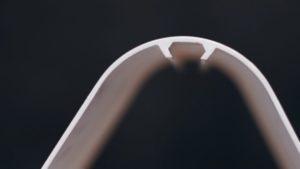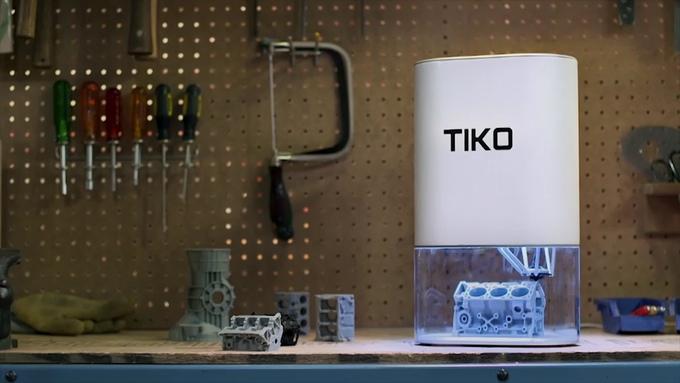 The Tiko 3D Printer seemed too good to be true, and maybe it is. The company admits that it has fired staff and is low on cash. It seems to be seeking investment while as many as 12,000 backers may not have gotten their 3D printers. What happened?
The Tiko 3D Printer seemed too good to be true, and maybe it is. The company admits that it has fired staff and is low on cash. It seems to be seeking investment while as many as 12,000 backers may not have gotten their 3D printers. What happened?
Unibody Dreams
The $179 3D printer raised $2.9 million on Kickstarter. The project had 16,538 backers who all eagerly awaited their low-cost 3D printer. The team touted their unibody frame as being key to the Tiko’s success. By having the frame made out of one part they would save considerably on the assembly and manufacturing costs. They also thought that the combination of a delta type 3D printer in a unibody frame would be an ideal one. By being accurate and enclosed the printer could be safe, strong, light and easy to use. They created a drive system to work inside the rails of the unibody frame and had a lot of custom ordered parts and electronics. Instead of active model cooling through fans they designed a “passive cooled liquefier” that would replace them: “At its core are the carefully designed convection-optimizing heat vents. These vents maximize the upward flow of hot air while shielding the heatsink. The exact specifications are secret, but Tiko’s liquefier maintains a remarkably low inlet temperature without any forced airflow—even inside a warm print chamber.” Liquefier, by the way, is Tiko-speak for hot end. Meanwhile their flexible bed was not heated again saving on cost. The team seemed to imply that the heat from the nozzle would be enough to heat the chamber entirely while their passive cooled liquefier would at very low assembly cost replace fans. In the Kickstarter risks section the team mentioned moving towards injection molding from prototypes. They didn’t discuss any risks in developing firmware, getting custom electronics to work or 3D printing at all. They didn’t see any potential assembly or integration risk. They wanted to develop their own slicing software from scratch and didn’t see any risks that could potentially derail that. They didn’t perceive any risk on not using fans and did not see any design risk at all. They just said, “you can sit back and relax—with Tiko, you’re going to get everything you hoped for and then some!”
You Can Sit Back and Relax
At first glance it seemed like a clean nice looking design. Clever value engineering used to drastically reduce the cost of 3D printing. The machine looked pretty and looked like it may just work. Using one part as the body, chassis and part of the rails reduced significant costs. Removing fans and a heated bed drastically reduced costs as well. But, would it work? If you looked at the costs of parts and components it seemed like the Tiko was rather ambitiously planned. Yes, they may be able to get it to work for that amount of money but nothing could go wrong. A simple estimate meant that even if assembly costs themselves were low they were looking at perhaps $90 in part and engineering costs, assuming that there were no hidden surprises there. The team itself mentioned a $70 COGS which would seem to be highly optimistic. The unibody idea itself of course is a wonderful one. By having a plastic body however any vibration in the printer would propagate through it. Backlash or resonance in the motors or moving parts would extend throughout the frame and perhaps interfere with print quality. Even though there are a lot of stiff plastics out there and plastics that could dampen these effects this may be quite difficult to solve.
Generally however one could not but help and look at this pretty thing and conclude that it would be yet another Kickstarter-clusterfuck. Not because the idea was fundamentally flawed but because the team simply did not seem sufficiently grounded in the reality of developing a 3D printer and getting it manufactured. A 3D printer is like a cookie. Anything can be a cookie and anyone can make a cookie. But, to make a better cookie or even a decent cookie when compared to other cookies is exceedingly difficult. To then make thousands on a budget and tight schedule is incredibly difficult. To then do this with a limited understanding of the realities of manufacturing and with limited expertise is harder still.
We Dun Goofed Big Time
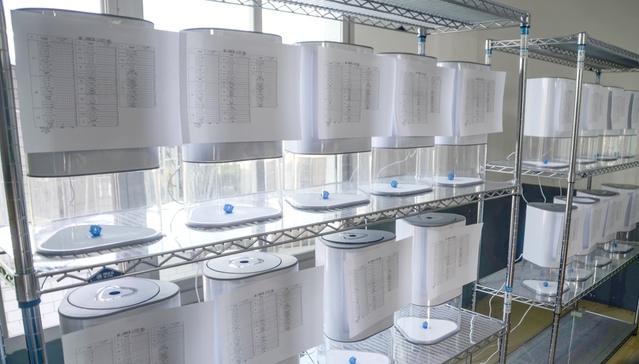 The Kickstarter closed on April 30th, 2015. The printer was expected to ship in November 2015 and started shipping in July 2016. Much of the 3D printing community was initially very skeptical about the Tiko. Since the machine is closed source some negative comments were to be expected. But, even in the case of much bigger flare ups and Kickstarter-kicked to the curb disasters there was quite a lot of negative commenting by the community. There was also a lot of very helpful sharing of insights and suggestions which were uniformly brushed aside. Take that discussion about a $70 COGS cost. During a Reddit AMA someone quite rationally suggested that they couldn’t have a COGS cost yet since they could not have at that time known their final labor, packaging and inventory costs. This was met with a, “We understand your skepticism but are not incompetent.” Another Reddit user pointed out that on average Kickstarter printers take one year and the Tiko team had promised to ship in seven months. And that if they shipped in November it would be a “zero slip zero test” schedule. This would mean that nothing could go wrong and in fact there was no margin for error or delays and indeed they could not test properly during that time frame. The team thought that the same timeline gave them “plenty of buffer room.”
The Kickstarter closed on April 30th, 2015. The printer was expected to ship in November 2015 and started shipping in July 2016. Much of the 3D printing community was initially very skeptical about the Tiko. Since the machine is closed source some negative comments were to be expected. But, even in the case of much bigger flare ups and Kickstarter-kicked to the curb disasters there was quite a lot of negative commenting by the community. There was also a lot of very helpful sharing of insights and suggestions which were uniformly brushed aside. Take that discussion about a $70 COGS cost. During a Reddit AMA someone quite rationally suggested that they couldn’t have a COGS cost yet since they could not have at that time known their final labor, packaging and inventory costs. This was met with a, “We understand your skepticism but are not incompetent.” Another Reddit user pointed out that on average Kickstarter printers take one year and the Tiko team had promised to ship in seven months. And that if they shipped in November it would be a “zero slip zero test” schedule. This would mean that nothing could go wrong and in fact there was no margin for error or delays and indeed they could not test properly during that time frame. The team thought that the same timeline gave them “plenty of buffer room.”
Testing is an important part of any new product’s development. 3D printers however are a result of a complex interplay between mechanical engineering, firmware, software and materials. Usually a lot of issues are exposed during testing when developing a 3D printer. There are a lot of unforeseen problems that arise at this stage but the team did not seem to anticipate any. They also said that “some of their prototype parts won’t translate properly into production. Not because of design flaws, moreso because of tolerances.” The assumption that the design was somehow perfect and not open to revisiting was also worrying. Tolerances can indeed be a significant issue when developing a 3D printer. Often however QA on parts, unanticipated interactions between parts and failure modes that were not predicted in advance prove to be more difficult. Tiko failed to ship that November 2015 and later said in April 2016 that their goal was to ship in July, if the “first Tikos haven’t shipped then we dun goofed big time.” In September the team delayed shipping once again. In November they said that the printers were setting sail with 1,000 Tikos being shipped to Vancouver to be distributed from there. On the 20th of December 2016 they announced that the first batch was shipped. Canada and the US have received delivery of Tikos but others in Europe seem to still be waiting for their orders.
We Opened Our Own Factory! We Were No Longer the Three Kids from Dalhousie
 Initially the company said that they were “one of the few kickstarter 3D printers who do not want to open up their own manufacturing facility” in April. By July they had decided to open their own factory. “We are less than one week away from shipping the first production Tiko’s – this Friday, July 1st!.”
Initially the company said that they were “one of the few kickstarter 3D printers who do not want to open up their own manufacturing facility” in April. By July they had decided to open their own factory. “We are less than one week away from shipping the first production Tiko’s – this Friday, July 1st!.”
“As you may recall, we started this endeavor with the mindset that ‘We’ll leave production to contract manufacturers – they know what they’re doing.’ Turns out it wasn’t that simple, so we came here ourselves and started working alongside them. And what would you know… we were pretty good at it….
But we thought to ourselves: Okay, sure. We can stand over another companies’ shoulders and ensure parts are made to spec. But overseeing assembly, QC, logistics, etc? Best leave that to an experienced company, and just check up on them. Right?
Well, after everything we experienced and everything we learned, we realized we were actually pretty good at this stuff. We had solid connections in China, and had grown into strong, well organized leaders. We were no longer the three kids from Dalhousie – we were young professionals, backed up by an awesome team at home and abroad. It was time to move up a level.
And so, back in February, we made a decision. A decision that would forever alter the future of Tiko…
SURPRISE!
That’s right, we opened our very own Tiko factory! Two stories tall, with our own equipment!”
A Decision That Would Forever Alter the Future of Tiko
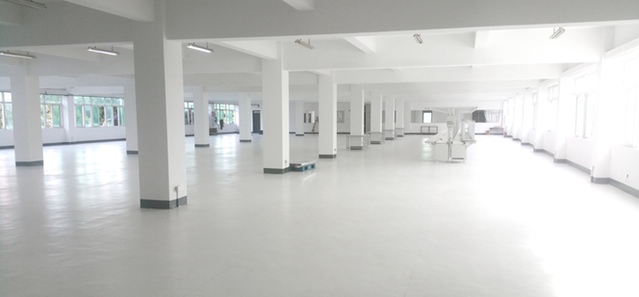 “Our very own operation! Ahhh how cool is that!? No more shenanigans – we can finally oversee everything ourselves and ensure Tiko is built our way. There’s no corner cutting on our watch!” Who does this? Without seemingly referring to any real problems or issues and concluding, “we realized we were actually pretty good at this stuff” they then decided to open a factory? A factory in China and you want to open and run it yourselves and manufacture? And this is a skill you’ve acquired recently but you feel confident enough about it that you could run your own manufacturing operation?
“Our very own operation! Ahhh how cool is that!? No more shenanigans – we can finally oversee everything ourselves and ensure Tiko is built our way. There’s no corner cutting on our watch!” Who does this? Without seemingly referring to any real problems or issues and concluding, “we realized we were actually pretty good at this stuff” they then decided to open a factory? A factory in China and you want to open and run it yourselves and manufacture? And this is a skill you’ve acquired recently but you feel confident enough about it that you could run your own manufacturing operation?
They posted this on June 27th, 2016. They didn’t yet have a business license, couldn’t hire anyone, had no staff, were looking to start recruiting their first staff. Yet, then want to be manufacturing 10,000 3D printers a month in July? So they have an empty building and want to hire everyone, get equipment, train people, get all their parts shipped in, get a business license and then start manufacturing and scale to 10,000 units all within four weeks?
“Oh, what an illustrious future we have! We’re already putting together a team of supply chain managers to ensure we don’t experience any interruptions as we scale production, and soon we’ll be hiring manufacturing engineers to help with future projects and accelerate R&D.
This isn’t Kansas anymore, and the paperwork is intense. Until it’s done, we can’t officially hire people (except contractors), move certain equipment into the facility, export under our company name, etc.
Other than that, it’s pretty much ready to go. The renovations are practically finished, the assembly equipment mostly installed, and the business license almost granted. We’re looking at one, maybe two more weeks before the show is underway.
Now, given that we’re short on staff and space, we’ll have to start slow and work our way up. We’ll only be able to ship a couple of hundred printers this week, but by next week it will be closer to 500, and once we move the operation to our factory it’ll be in the thousands. By the end of July we’ll reach full steam ahead – approximately 10,000 printers per month. This is limited only by the production rate of certain components, however we’re making additional molds and expanding that capacity over the summer, so the sky is the limit!”
“A decision that would forever alter the future of Tiko” seems to imply that they’re well on their way to building Intel. “Oh, what an illustrious future we have” does not in any way suggest the required humility and realism needed to actually build a manufacturing facility in China capable of producing 10,000 3D printers a month. This is an additional challenge that the team has taken on but will not in any way impact their operations? No one is building 10,000 3D printers a month. Many companies have gone bust trying to outsource or scale manufacturing to numbers a tenth of that. This is a Kickstarter project that is a year late with getting to market at this point and their language is more akin to that of the 50 Year McDonald’s Corporation History book. Other than the governmental permissions, “it’s pretty much ready to go” well apart from them not having staff and assuming that they will encounter no problems what so ever.
URGENT* – Last Call for Shipping Surveys!!
 In the same grandiose post Tiko mentions, “The cost on our end works out to approximately the same either way, so we’ll continue to collect $55USD for shipping.” They then started billing their Kickstarter backers $55 in shipping to get their $179 3D printers. They said that, “If we don’t have your shipping information/payment by July 1st, your printer will be shipped via direct shipping rather than hub and spoke, and trust us, you don’t want that.” Their hub and spoke model suggested that by paying $55 it would be shipped by container to hubs worldwide and then onward to the customer. If you opted for this then the import fees would be included. If you did not pay them by July 1st they would ship direct for $55 and the import fees would not be included. “Due to your country’s Taxes/VAT’s/Duties/Brokerage Fees/etc if you miss the July 1st boat and opt for direct shipping, you could get hit with a pretty hefty COD upon receiving your Tiko – in some countries it could be more than $100.” The implication is that if you opt for hub shipping that Tiko would cover the import fee.
In the same grandiose post Tiko mentions, “The cost on our end works out to approximately the same either way, so we’ll continue to collect $55USD for shipping.” They then started billing their Kickstarter backers $55 in shipping to get their $179 3D printers. They said that, “If we don’t have your shipping information/payment by July 1st, your printer will be shipped via direct shipping rather than hub and spoke, and trust us, you don’t want that.” Their hub and spoke model suggested that by paying $55 it would be shipped by container to hubs worldwide and then onward to the customer. If you opted for this then the import fees would be included. If you did not pay them by July 1st they would ship direct for $55 and the import fees would not be included. “Due to your country’s Taxes/VAT’s/Duties/Brokerage Fees/etc if you miss the July 1st boat and opt for direct shipping, you could get hit with a pretty hefty COD upon receiving your Tiko – in some countries it could be more than $100.” The implication is that if you opt for hub shipping that Tiko would cover the import fee.
Was this an attempt by the company to get more money from backers to keep Tiko going? Depending on how well they negotiated with whom the charge could be a bit excessive. By this point two years into the Tiko Kickstarter their backers were nervous, displayed indignation or were openly hostile:
“Hello, backer 5,771 here, meaning shipping expectation March 2056”
“You guys are now the _worst_ project I have ever backed. Two years with barely any updates. THIEVES!!!! ლ(`ー´ლ)”
“Please publish an update. The lack of formal information is concerning. I know you guys are dealing with issues, but your investors would appreciate some transparency. We back projects for a variety of reasons, one of them being that we like to be part of the process – but I don’t feel I’m part of the process here.”
“What is happening with this?? Delivery has been massively delayed and there have been absolutely no updates or explanations for this for a very long time now!!
Can we please get an explanation and an update.”
Incompetent Tiko Management Dropping By
All throughout this period the team seemed insular and filled with optimism and hubris. They referred to anyone posting negative comments or questions as trolls and started to in a rather passive aggressive way lash out. A Kickstarter comment by the team:
“Incompetent Tiko management dropping by to deliver a super-professional comment… just kidding, what’d we tell you, did that last one get them wound up or what?
We take customer service seriously and have discretely processed thousands of support tickets over the past year, but we know a troll when we see one, and pissing them off here has been the best part of this campaign. It won’t last much longer, so we’ve got to crank it up a notch or two before the party is over.
Come on guys, you’ve tried so hard to bring us down this past year, but gotten nowhere. Show us what you’ve got!
Cheers!
Team Tiko”
And this gem:
“To those of you who wish to rant, unconstructively criticize, or lob conspiracy theories and accusations at us, don’t expect to be dignified with a response. We’ve worked too hard and made to many sacrifices to come here and argue with you, just because you’ve lost your nerve at the first sign of trouble.”
Or this:
“That’s it, thats the best you guys could come up with? Ugh. Weak.”
This is not a very professional way to deal with being two years late with shipping the printer and the ensuing criticism because of this. The team seemed harried and giving up and rarely updated backers. “Just dropping by to show signs of life, as we’re mostly hunkered down and glued to our computers this week as we make the last round of slicer improvements before the holidays.” There were issues in getting their slicing software out the door as well. Printers were being shipped though and the first comments were coming in.
I Am NOT Happy
Approximately 12,000 people didn’t get their printers and of the ones who did, problems emerged.
“Finally received my Tiko. It won’t connect to wifi, won’t load filament, filament keeps breaking, two of the struts have a permanent bend in them from the bowden tube/hot end wires being jammed under them during shipping and the clear plastic base is loose and separated from the aluminum body. After waiting over a year to receive this printer, I am NOT happy and intend to return it immediately. It also sounds like I am one of many with all of these same problems.”
The problem with the struts being bent from the bowden tube being put underneath them was widely reported. The filament breaking issue was also something people kept mentioning. This may have been due to the same problem. The struts also broke when the Tiko was in standby mode and seemed to not be strong enough in general. These arm struts also seemed to have far too much flex in the final Tikos. There were also a lot of build quality issues with parts incorrectly assembled or loose. The amount of misprints was also very high and the print quality of those that succeeded was poor. One possible problem that people did mention earlier was the motors. The 28BYJ-48 motors in the Tiko have about a tenth of the power of the NEMA steppers more commonly seen on 3D printers. Comments in the Reddit AMA and elsewhere suggested that this would make the Tiko underpowered.
Reviews
When Tikos finally started making their way to reviewers they had a field day with them.
Some others showed that if you used Cura to slice and picked a rather forgiving model you could have some decent results from the printer.
Generally people were disappointed in their Tikos. Thousands complained online and many tried to return the machines. It is still difficult to tell at the moment if it is a bad 3D printer. It seems that a lot of bad feeling has built up between Tiko and its prospective customers. With it being underpowered and having problems with its bowden tube and struts there do seem to be some critical flaws in the current machine. There is a lot of misprinted individual layers that seem to point to a big issue either with power or feeding through the material. These flaws could be ironed out but it seems unlikely that Tiko will be able to do this.
This Project Is Not Over
“That said, this project is not over. Yes, we had to lay off most of our staff, but we still have a roadmap for additional shipments, and successful project completion is actually quite viable. We do, however, need to weigh our options carefully, and we may have to make some difficult decisions. We would like you to be a part of this process, and we’ll do that right here with you in the comments section.”
And a later Kickstarter comment:
“Sigh. It’s not that simple. But yes, we had to make some hard choices to cut our burn rate. We had to let a lot of people go, including a number of interns who were supposed to start in January. It was the hardest decision of our lives. We know we screwed up, but we’re just trying to get back on track, and we are making progress. We actually have plans for additional batches regardless of any investment, but if this devolves into chaos and people panic, then we are as good as finished, and nobody will gain a thing from it. So, where do you guys want to go from here?”
And another:
“We know we’ve disappointed many of you, but we’ve been in over our heads for a long time now. We’re doing what we can to get back on our feet. Thank you to everyone who has shown us support and compassion. You make this journey worthwhile.”
Tiko at last shows some contrition. The company admits that it has essentially run out of money or is close to doing so. It has laid off staff and is admitting to problems. What will the future hold for Tiko? The bad feeling that has built up between the company and its customers seems to preclude any possible solution. Many of its customers feel cheated by the company and are very unhappy by the accumulated delays. The company still has to deliver approximately 12,000 printers. We don’t know how far they are with those and how much capital they would need to complete these shipments. Even if some new funding could be found or they could fix the 3D printer’s issues any positive resolution seems unlikely.
What Happened, Bro?
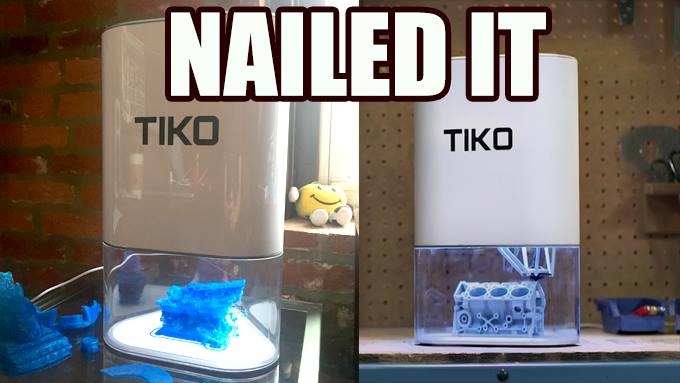 As far as we can tell right now it seems that a degree of overconfidence is what really plagued this project. A lack of interest in being realistic about deadlines, challenges and possible delays seems to have really hurt the company. None of the technical challenges were insurmountable. There seem to have been some flaws in the initial design. These could have been ironed out. Along the way there were significant problems with expectation management as well. It was all smooth sailing and conquer the world until it suddenly ground to a halt. There was a real lack of communication with their Kickstarter community. Gradually this devolved into a very acerbic passive aggressive style of communicating with people that put a lot of people off. Delays were unanticipated and the company often didn’t respond for months.
As far as we can tell right now it seems that a degree of overconfidence is what really plagued this project. A lack of interest in being realistic about deadlines, challenges and possible delays seems to have really hurt the company. None of the technical challenges were insurmountable. There seem to have been some flaws in the initial design. These could have been ironed out. Along the way there were significant problems with expectation management as well. It was all smooth sailing and conquer the world until it suddenly ground to a halt. There was a real lack of communication with their Kickstarter community. Gradually this devolved into a very acerbic passive aggressive style of communicating with people that put a lot of people off. Delays were unanticipated and the company often didn’t respond for months.
A realistic understanding of the realities of manufacturing would have made this project more realistic from the outset. Looking back it seemed that three kids from Dalhousie thought that they were bright enough to solve all the problems that they would encounter. They set off with a lot of money and little humility to make 3D printers. They simply didn’t learn quickly enough or listen to experienced people enough. They then burned through a few million dollars. Now we have several thousand people worldwide waiting for 3D printers that may never come. Caveat emptor. Discuss in the Tiko forum at 3DPB.com.
Subscribe to Our Email Newsletter
Stay up-to-date on all the latest news from the 3D printing industry and receive information and offers from third party vendors.
You May Also Like
3D Printed Heat Spreader Could Improve Efficiency of Electronics
The low-hanging fruit for decarbonization has long been improving the efficiency of existing systems, hence the justification for LED lights and ENERGY STAR certified appliances. While such minor moves are...
3D Printing News Unpeeled: Marine Gearboxes, 3D Printed Motors and $1.7 Million in Seed Funding
UK based Equipmake just released their Ampere-220 e-axle system. The system, which is meant for high performance electric cars, was similar to one released on the Ariel HIPERCAR. It has...
CEAD Unveils 36-Meter-Long 3D Printer for Abu Dhabi’s Al Seer Marine
CEAD, a Dutch original equipment manufacturer dedicated to large-format 3D printers, has unveiled what it claims to be the world’s largest robotic arm-based 3D printer. At 36 meters long and...
3D Printed Biocomposites Could Help Reduce Marine Plastic Pollution
Concerns about the impact of plastic litter and microplastics in the oceans are at the forefront of environmental study. For decades, the marine environment has suffered from the degradation of...


